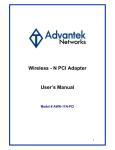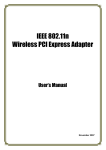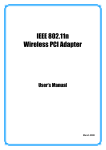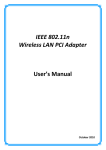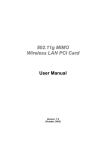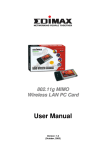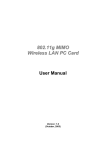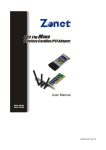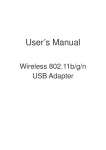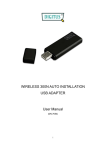Download Advantek Networks AWN-PCI-11N
Transcript
Wireless - N PCI Adapter User’s Manual Model # AWN-PCI-11N 1 FCC Warning This equipment has been tested and found to comply with the limits for a Class C digital device, pursuant to part 15 of the FCC Rules. These limits are designed to provide reasonable protection against harmful interference in a residential installation. This equipment generates, uses, and can radiate radio frequency energy and, if not installed and used in accordance with the instructions, may cause harmful interference to radio communication. However, there is no guarantee that interference will not occur in a particular installation. If this equipment does cause harmful interference to radio or television reception, which can be determined by turning the equipment off and on, the user is encouraged to try to correct the interference by one or more of the following measures: - Reorient or relocate the receiving antenna. - Increase the separation between the equipment and receiver. - Connect the equipment into an outlet on a circuit different from that to which - Consult the dealer or an experienced radio/TV technician for help. the receiver is connected. FCC Caution: Any changes or modifications not expressly approved by the party responsible for compliance could void the user’s authority to operate this equipment. This device complies with Part 15 of the FCC Rules. Operation is subject to the following two conditions: (1) This device may not cause harmful interference, and (2) this device must accept any interference received, including interference that may cause undesired operation. IMPORTANT NOTE: FCC Radiation Exposure Statement: This equipment complies with FCC radiation exposure limits set forth for an uncontrolled environment. This equipment should be installed and operated with a minimum distance of about eight inches (20cm) between the radiator and your body. This transmitter must not be co-located or operated in conjunction with any other antenna or transmitter. Modular Approval Statement: This device is intended to be used only for OEM integrator under the following conditions: 1) The antenna must be installed such that 20 cm is maintained between the antenna and users, and 2) The transmitter module may not be co-located with any other transmitter or antenna. IMPORTANT NOTE: 2 In the event that these conditions cannot be met (for example certain laptop configurations or co-location with another transmitter), then the FCC authorization is no longer considered valid and the FCC ID cannot be used on the final product. In these circumstances, the OEM integrator will be responsible for re-evaluating the end product (including the transmitter) and obtaining a separate FCC authorization. Revision History Revision V1.0 History First release All brand and product names mentioned in this manual are trademarks and/or registered trademarks of their respective holders. 3 Contents 1. Introduction ........................................................................... 5 1.1 Features................................................................................................ 5 1.2 LED Indicator........................................................................................ 5 1.3 Package Contents................................................................................ 6 1.4 Before you start ................................................................................... 6 1.5 Hardware Installation........................................................................... 6 2. Installation Procedure........................................................... 8 2.1 For Windows XP and 2000................................................................... 8 2.2 For Vista ............................................................................................. 14 3. Wireless Network Configuration Utility ............................. 19 3.1 For Windows XP & 2000 ............................................................................ 19 3.1.1 Start ......................................................................................... 25 3.1.2 Profile ...................................................................................... 31 3.1.3 Network ................................................................................... 36 3.1.4 Advanced ................................................................................ 37 3.1.5 Statistics ................................................................................. 38 3.1.6 WMM........................................................................................ 39 3.1.7 WPS ......................................................................................... 45 3.1.8 About....................................................................................... 48 3.1.9 Link Status .............................................................................. 49 3.1.10 Enable AP Mode Feature in Windows 2000 OS ................... 50 3.2 For Windows Vista..................................................................................... 56 3.2.1 Profile ...................................................................................... 56 3.2.2 Link Status .............................................................................. 64 3.2.3 Site Survey.............................................................................. 65 3.2.4 Statistics ................................................................................. 69 3.2.5 WPS Configuration................................................................. 72 3.2.6 QoS.......................................................................................... 74 3.2.7 About....................................................................................... 81 3.2.8 How to Manage Windows Profile........................................... 82 4. Troubleshooting.................................................................. 86 4 1. Introduction This is a wireless client device that delivers unrivaled wireless performance for your Desktop PC. It complies with IEEE 802.11n draft standard and backward compatible with IEEE 802.11b/g. With this adapter, you can easily upgrade your Desktop PC wireless connectivity. Once the wireless PCI adapter is connected, access the network with high-speed Internet connection while sharing photos, files, music, video, printers, and storage. Get a better Internet experience with a faster wireless connection so you can enjoy smooth digital phone calls, gaming, downloading, and video streaming. It also provides peer-to-peer communication among any compatible wireless users and no Access Point required. This Wireless PCI Adapter provides maximum transfer rate up to 150Mbps and supports WEP, WPA, WPA2 and WPS high-level WLAN security features that guarantee the best security for users. This product is made in ISO9001 approved factory and complies with FCC part 15 regulations and CE approval. 1.1 Features • Complies with draft IEEE 802.11n standard • Up to 150Mbps data transfer rates in 802.11n mode • Backward compatible with IEEE 802.11b/g • Legacy and High Throughput Modes • 20MHz/40MHz bandwidth • Supports 64/128-bit WEP Data Encryption • Supports WPA, WPA2, WPS, 802.11i advanced security • Supports both Infrastructure and Ad-Hoc Networking Modes • Supports Quality of Service (QoS) - WMM, WMM-PS • Supports Windows 2000/XP/Vista • Simple user setup and diagnostics utilities 1.2 LED Indicator LED Light Status ACT Blinking LINK On Description Data is being transmitted or received. Wireless link is established. 5 1.3 Package Contents • One Wireless PCI Adapter • Two External Antennas • One CD-ROM (Drivers / Utility, User’s Manual) If any of the above items is missing, contact your dealer immediately. 1.4 Before you start You must have the requirements as follow, • A computer with an available PCI slot • At least a 300MHz processor and 32MB memory • Windows 2000/XP/Vista support • A CD-ROM drive • Wireless PCI Adapter properly installed 1.5 Hardware Installation STEP 1: Turn off your computer and remove its cover STEP 2: Insert the PCI card to an available PCI slot firmly. Please refer to the illustration below: STEP 3: Secure this card to the rear of the computer chassis and put back the cover. STEP 4: Secure the antenna to antenna connector of the card. Please refer to the illustration below: 6 STEP 5: Turn on the computer. [Guidelines for the Hardware Installation] Please observe the following guidelines when you are installing the PCI card to the Desktop PC: Avoid placing the PC close to obstacles Obstructions such as concrete and thick walls limit radio signal penetration and reduce the throughput and the coverage range of the PCI card. Place the PC as high as possible The higher the PC is placed, the better the performance. Adjust the antenna position The WLAN PCI card has one antenna for signal reception and another one antenna for high power signal transmission. The antenna on the right side is for signal reception and should be set perpendicular (90 degrees). The left side is for signal transmission and should be set about 90 degree 7 2. Installation Procedure Note: If you have installed the Wireless Adapter driver & utility before, please uninstall the old version first. 2.1 For Windows XP and 2000 STEP 1: Found New Hardware Wizard is displayed after the adapter is installed and the computer is restarted. Please click Cancel to continue. (For Windows XP) (For Windows 2000) 8 STEP 2: Insert Installation CD into CD-ROM drive then windows below will appear. Click Install Driver to begin device driver installation. STEP 3: Please read the following license agreement. Use the scroll bar to view the rest of this agreement. Select I accept the terms of the license agreement and click Next to continue. 9 STEP 4: In Windows XP, there is a Windows Zero Configuration Tool for you to setup wireless adapter. You can choose to configure the adapter through the Microsoft Zero Configuration Tool or the Ralink Configuration Tool. It is recommended to choose the Ralink Configuration Tool for the adapter. Click Next to continue. STEP 5: If you need the adapter to operate with better performance, please choose Optimize for performance mode to enable the Tx Burst mode. Or you can choose Optimize for WiFi 10 mode to run in standard wireless network. STEP 6: Click Install to begin the installation. STEP 7: Please wait for a while during the adapter is configuring your new software installation. 11 STEP 8: After the setup wizard has successfully installed wireless LAN, click Finish to exit the wizard. 12 To check if the adapter is properly installed, you can right-click My Computer choose Properties click Device Manager. (For Widows XP) (For Widows 2000) The Configuration Utility appears as an icon on the system tray of Windows while the adapter is running. You can open the utility by double-click on the icon. Right-click the icon, there are some items for you to operate the configuration utility, Launch Config Utilities Select this option to open the Configuration Utility tool. Use Zero Configuration as Configuration utility Select this option to use Windows XP built-in wireless configuration utility (Windows Zero Configuration) to configure to card. Switch to AP Mode Select this option to change to AP mode. Exit Select Exit to close the Configuration Utility tool. 13 2.2 For Vista STEP 1: Found New Hardware Wizard is displayed after the adapter is installed and the computer is restarted. Please click Cancel to continue. STEP 2: Insert Installation CD into CD-ROM drive then windows below will appear. Click Install Driver to begin device driver installation. 14 STEP 3: Please read the following license agreement. Use the scroll bar to view the rest of this agreement. Select I accept the terms of the license agreement and click Next to continue. STEP 4: Click Install to begin the installation. 15 STEP 5: Please wait for a while during the adapter is configuring your new software installation. 16 STEP 8: After the setup wizard has successfully installed wireless LAN, click Finish to exit the wizard. To check if the adapter is properly installed, you can right-click My Computer choose Properties click Device Manager. 17 The Configuration Utility appears as an icon on the system tray of Windows while the adapter is running. You can open the utility by double-click on the icon. Ralink wireless utility needs to cooperate with Microsoft AutoConfig service in order to perform scanning and connecting actions, so the AutoConfig service should be enable beforehand. Control Menu Once Ralink wireless utility is minimized, the user can click the Ralink icon on the taskbar to bring up the control menu. Launch Config Utilities Restore Ralink wireless utility window. Switch to AP Mode Select this option to change to AP mode. Exit Select Exit to close the Configuration Utility tool. 18 3. Wireless Network Configuration Utility 3.1 For Windows XP & 2000 The Configuration Utility is a powerful application that helps you to configure the Wireless LAN adapter and monitor the link status and statistics during the communication process. When the adapter is installed, the configuration utility will be displayed automatically. This adapter will auto connect to wireless device which has better signal strength and no wireless security setting. In Windows XP, it provides wireless configuration utility named “Windows Zero configuration” which provides basic configuration function for Ralink Wireless NIC, Ralink’s Utility (RaUI) provides WPA supplicant functionality. To make it easier for user to select the correct utility, RaUI will let user make the selection when it first runs after windows XP boots. RaUI can co-exist with WZC (Windows Zero Configuration). When coexisting with WZC, RaUI only provides monitoring function, such as link status, network status, statistic counters, advance feature status, WMM status and WPS status. It won’t interfere with WZC’s configuration or profile functions. Please see below picture: To select WZC or RaUI If “Use Zero Configurations as Configuration utility” is selected, please continue on the section. Below picture shows that the RaUI status when WZC is active as main control utility. 19 When activating WZC, there are couple different on RaUI status compare to the without WZC running: (1) Profile button will be gray, profile function is removed since the NIC is controlled by WZC. (2) The connect and add profile function will be gray. The reason is same as the first difference. 20 [Use WZC to configure wireless NIC] STEP 1: If connection is lost or not connected, the status prompt as below will pop up. STEP 2: Right-click the network connection icon in the task bar. STEP 3: Select “View Available Wireless Networks” will pop up the dialog shown as below. 21 STEP 4: Select intended AP and click “Connect” shown as below, then click “Connect Anyway”. STEP 5: AP1 is successful connected. 22 STEP 6: If you want to modify information about AP, click “Change advanced settings” STEP 7: Choose “Wireless Networks” tab. 23 STEP 8: Click “Properties” and then click “OK” button. STEP 9: After filling appropriate value, click “OK” button. And the status will prompt up as 24 below. STEP 10: Click the Ralink’s icon will bring up RaUI main window. User can find the surrounding APs in the list. The current connected AP will also shown with the green icon indicated as below screen. User may user the available tab to configure more advanced features provided by Ralink’s wireless NIC. 3.1.1 Start When starting RaUI, system will connect to the AP with best signal strength without setting profile or matching profile setting. It will issue a scan command to wireless NIC. After two seconds, the AP list will updated with the result of BSS list scan. The AP list include most 25 used fields, such as SSID, network type, channel used, wireless mode, security status and signal percentage. The arrow icon indicates the connected BSS or IBSS network. There are three sections in RaUI. These sections are briefly described as below. Button Section: include Profile page, Network page, Advanced page, Statistics page, WMM page, WPS page, About button, Radio On/Off button and Help button. Button Section Move to the Left Move to the Right 26 Function Section: Corresponding button Profile Page Network Page Advanced Page 27 Statistics Page WMM Page WPS Page 28 About Page Status Section: Include Link Status, Authentication Status, AP’s information, Configuration and retrying the connection when authentication is failed. Link Status Authentication Status 29 AP’s Information Retry the Connection Configuration At the mean time of starting RaUI, there is also a small Ralink icon appears within windows taskbar as below. You may double click it to bring up the main menu if you 30 selected to close RaUI menu earlier. You may also use mouse;s right button to close RaUI utility. Ralink icon in system tray. Besides, the small icon will change color to reflect current wireless network connection status. The status indicates as follow: -- indicate Connected and Signal Strength is Good. -- indicate Connected and Signal Strength is Normal -- indicate Wireless NIC is not connected yet -- indicate Wireless NIC is not detected -- indicate Connected and Signal Strength is Weak 3.1.2 Profile Profile can book keeping your favorite wireless setting among your home, office, and other public hot-spot. You may save multiple profiles, and activate the correct one at your preference. [Definition of each field] Profile Name: Name of profile, preset to PROF ( indicate 1,2,3,…) SSID: AP or Ad-Hoc name Network Type: Network’s type, including infrastructure and Ad-Hoc. Authentication: Authentication mode Encryption: Encryption Type Use 802.1x: Whether or not use 802.1x feature Channel: channel in use for Ad-Hoc mode Power Save Mode: Choose from CAM (Constantly Awake Mode) or Power Saving Mode. Tx Power: Transmit power, the amount of power used by a radio transceiver to send the signal out. RTS Threshold: User can adjust the RTS threshold number by sliding the bar or key in the 31 value directly. Fragment Threshold: User can adjust the Fragment threshold number by sliding the bar or key in the value directly. [Icons and buttons] indicate connection is successful on currently activated profile indicate connection is failed on currently activate profile indicate network type is infrastructure mode indicate network type is Ad-Hoc indicate security-enabled wireless network Add a new profile Edit an existing profile Delete an existing profile Activate selected profile Show the information of Status Section Hide the information of Status Section 3.1.2.1 Add/Edit Profile There are 3 methods to open Profile Editor form: You can open it from “Add to Profile” button in Site Survey function You can open it form “Add” button in Profile function You can open it from “Edit” button in Profile function 32 Profile Name: User can chose name for this profile, or use default name defined by system. SSID: User can key in the intended SSID name or use pull down menu to select from available APs. Power Save Mode: Choose from CAM [Constantly Awake Mode] or Power Saving Mode. Network Type: There are two types, infrastructure and 802.11 Ad-Hoc mode. Under Ad-Hoc mode, user can also choose the preamble type, the available preamble type includes auto and long. In addition to that the channel field will be available for setup in Ad-Hoc mode. RTS Threshold: User can adjust the RTS threshold number by sliding the bar or key in the value directly. The default value is 2347. Fragment Threshold: User can adjust the Fragment threshold number by sliding the bar or key in the value directly. The default value is 2346. Channel: Only available for setting under Ad-Hoc mode. User can choose the channel frequency to start their Ad-Hoc network. Authentication Type: There are 7 type of authentication modes supported by RaUI. They are Open, Shared, LEAP, WPA, WPA-PSK, WPA2, WPA2-PSK. Encryption Type: For open and shared authentication mode, the selection of encryption type are None and WEP. For WPA, WPA2, WPA-PSK and WPA2-PSK authentication mode, the encryption type supports both TKIP and AES. 802.1x Setting: It is an authentication for WPA and WPA2 certificate to server. WPA Pre-Shared Key: This is the shared secret between AP and STA. For WPA-PSK and WPA2-PSK authentication mode, this field must be filled with character longer than 8 and less than 32 lengths. WEP Key: Only valid when using WEP encryption algorithm. The key must matched AP’s key. There are several formats to enter the keys: Hexadecimal – 40bits: 10 Hex characters Hexadecimal – 128bits: 26 Hex characters. ASCII – 40bits: 5 ASCII characters ASCII – 128bits: 13 ASCII characters 33 3.1.2.2 Example to Add Profile in Profile Step 1: Click Add in Profile function Step 2: Add Profile page will pop up. 34 Step 3: Change profile name to what you want to connect. Pull down the SSID and select one intended AP. The AP list is the result of last Network. Step 4: Then, you can see the profile which you set appear in the profile list. Click “Activate” to activate the profile setting. 35 3.1.3 Network Under the Network function, system will display the information of surrounding APs from last scan result. List information includes SSID, BSSID, Signal, Channel, Encryption algorithm, Authentication and Network type as below: [Definition of each field] SSID: Name of BSS or IBSS network Network Type: Network type in use, infrastructure for BBS, Ad-Hoc for IBSS network Channel: Channel in use. Wireless Mode: AP support wireless mode. IT may support 802.11a, 802.11b, 802.11g or 802.11n wireless mode. Security-Enable: Whether AP provides security-enabled wireless network Signal: Receive signal strength of specified network [Icons & Buttons] Indicate connection is successful. Indicate network type is infrastructure mode. Indicate network type is Ad-Hoc mode. Indicate security-enabled wireless network. Indicate 802.11a wireless mode Indicate 802.11b wireless mode. Indicate 802.11g wireless mode. Indicate 802.11n wireless mode. Indicate the AP lists are sorted by SSID, Channel, or Signal. 36 Command to connect to the selected network. Issue a rescan command to wireless NIC to update information on surrounding wireless network. Add the selected AP to Profile setting. It will bring up profile page and save user’s setting to a new profile. [Connected Network] (1) When RaUI first ran, it will select the best AP to connect automatically. (2) If user wants to connect to other AP, He can click “Connect: button for the intended AP to make connection. (3) If the intended network has encryption other than “Not Use”, RaUI will bring up the security page appropriate information to make the connection. (4) When you double-click on the intended AP, you can see AP’s detail information. 3.1.4 Advanced Wireless Mode: Select wireless mode. 802.11B only, 802.11B/G mix, and 802.11B/G/N mix, modes are supported. (802.11 A/B/G mix selection item only exists for A/B/G adapter; 802.11B/G/N mix selection item only exists for B/G/N adapter; 802.11A/B/G/N mix selection item only exists for A/B/G/N adapter.) Wireless Protection: User can choose from Auto, On, and Off (Only 802.11n adapter don’t support) Auto: STA will dynamically change as AP announcement ON: Always send frame with protection. Off: Always send frame without protection. 37 TX Rate: Manually force the Transmit using selected rate. Default is auto. (802.11n wireless card doesn’t support.) Enable Tx Burst: Ralink’s proprietary frame burst mode. Enable TCP Windows Size: Enhance throughout. Fast Roaming at: Fast to roaming, setup by transmit power. Select your Country Region Code: 8 countries to choose. Show Authentication Status Dialog: When you connect AP with authentication, choose whether show “Authentication Status Dialog” or not. Authentication Status Dialog display the process about 802.11x Authentication. Enable CCX (Cisco Compatible eXtensions): support Cisco Compatible Extensions function. LEAP turn on CCKM Enable Radio Measurement: can channel measurement every 0~2000 milliseconds. Apply: Save the save changes Show the information of Status Section Hide the information of Status Section 3.1.5 Statistics Statistics page displays the detail counter information based on 802.11 MIB counters. This page translates the MIB counters into a format easier for user to understand. [Transmit Statistics] Frames Transmitted Successfully: Frames successfully sent. Frames Fail To Receive ACK After All Retries: Frames failed transmit after hitting retry limit. RTS Frames Successfully Receive CTS: Successfully receive CTS after sending RTS frame. 38 RTS Frames Fail to Receive CTS: Fail to receive CTS after sending RTS frame. Frames Retransmitted Successfully: Successfully retransmitted frames numbers Reset Counter: Reset counters to zero [Receive Statistics] Frames Received Successfully: Frames received successfully. Frames Received With CRC Error: Frames receive with CRC error. Frames Dropped Due To Out-Of-Resource: Frames dropped due to resource issue. Duplicate Frames Received: Duplicate received frames. Reset Counter: Reset counters to zero Show the information of Status Section Hide the information of Status Section 3.1.6 WMM WMM function involves “WMM Enable”, “WMM-Power Save Enable” and “DSL Setup”. WMM Enable: Enabe Wi-Fi Multi-Media. WMM-Power Save Enable: Enable WMM Power Save. Direct Link Setup Enable: Enable DLS (direct Link Setup). 39 [WMM Enable – Enable Wi-Fi Multi-Media] If you want to use “WMM-Power Save” or “Direct Link Setup” you must enable WMM. The setting methods of enabling WMM indicating as follow: Step 1: Click “WMM Enable” Step 2: Change to “Network” function. And add an AP that supports WMM features to a Profile. The result will look like the below figure in Profile page. 40 [WMM-Power Save Enable – Enable WMM Power Save] Step 1: Click “WMM-Power Save Enable” Step 2: Please select which ACs you want to enable. The setting of enabling WMM-Power Save is successfully. [Direct Link Setup Enable – Enable DLS (Direct Link Setup)] Step 1: Click “Direct Link Setup Enable” 41 Step 2: Change to “Network” function. And add an AP that supports DLS features to a Profile. The result will look like the below figure in Profile page. The Setting of DLS indicates as follow: (1) Fill in the blanks of Direct Link with MAC address of STA. The STA must conform to 2 conditions as follow: Connect with the same AP that support DLS features. Have to enable DLS 42 (2) Timeout Value represent that it disconnect automatically after some seconds. The value is integer. The integer must be between 0~65535. It represents that it always connects if the value is zero. Default value of Timeout Value is 60 seconds. (3) Click “Apply” button. The result will look like the below figure. Describe “DLS Status” as follow: (1) As the up figure, after configuring DLS successfully, show MAC address of the opposite side and Timeout Value of setting in “DLS Status”. In “DLS Status” of the opposite side, it shows MAC address of itself and Timeout Value of setting. (2) Display the values of “DLS Status” to “Direct Link Setup” as follow: 43 Step 1: In “DLS Status”, select a direct link STA what you want to show its values in “Direct Link Setup”. Step 2: Double-Click and the result will look like the below figure. (3) Disconnect Direct Link Setup as follow: Step 1: Select a direct link STA. 44 Step 2: Click “Tear Down” button. The result will look like the below figure. 3.1.7 WPS WPS Configuration: The primary goal of Wi-Fi Protected Setup (Wi-Fi Simple Configuration) is to simply the security setup and management of Wi-Fi networks. Ralink STA as an Enrollee 45 or external Registrar supports the configuration setup using PIN configuration method or PBC configuration setup using PIN configuration method or PBC configuration method through an internal or external Registrar. WPS AP List: Display the information of surrounding APs with WPS IE from last scan result. List information includes SSID, BSSID, Channel, ID (Device Password ID), Security-Enabled. Rescan: Issue a rescan command to wireless NIC to update information on surrounding wireless network. Information: Display the information about WPS IE on the selected network. List Information includes Authentication Type, Encryption Type, Config Methods, Device Password ID, Selected Registrar, State, Version, AP Setup Locked, UUID-E and RF Bands. PIN Code: 8-digit numbers. It is required to enter PIN Code into Registrar using PIN method. Each NIC Wireless has only one PIN Code of Enrollee. Config Mode: Our station role-playing as an Enrollee or an external Registrar. WPS Profile List: Display all of credentials got from the Registrar. List information includes SSID, MAC address, Authentication and Encryption Type. If STA Enrollee, credentials are created as soon as each WPS success. If STA Registrar, RaUI creates a new credential with WPA2-PSK/AES/64Hex-Key and doesn’t change until next switching to STA Registrar. Control items on WPS Profile List: Detail: Information about Security and Key in the credential Connect: Command to connect to the selected network inside credentials. The active selected credential is as like as the active selected Profile. Rotate: Command to rotate to connect to the next inside credentials Disconnect: Stop WPS action and disconnect this active link. And then select the last profile at the Profile Page of RaUI if exist. If there is an empty profile page, the driver will select any non-security AP. Delete: Delete an existing credential. And then select the next credential if exist. If there is an empty credential, the driver will select any non-security AP. PIN: Start to add to Registrar using PIN configuration method. IF STA Registrar, remember that enter PIN Code read from you Enrollee before starting PIN. PBC: Start to add to AP using PBC configuration method. When you click PIN or PBC, please don’t do any rescan within two-minute connection. If you want to abort this setup within the interval, restart PIN/PBC or press Disconnect to stop WPS connection. WPS associate IE: Send the association request with WPS IE during WPS setup. It is optional for STA. WPS probe IE: Send the probe request with WPS IE during WPS setup. IT is optional for STA. Progress Bar: Display rate of progress from Start to Connected status. 46 Status Bar: Display currently WPS Status. [WPS Information on AP] WPS information contain authentication type, encryption type, config methods, device password ID, selected registrar, state, version, AP setup locked, UUID-E and RF bands. Authentication Type: There are three types of authentication modes supported by RaConfig. There are Open, Shared, WPA-PSK, and WPA system. Encryption Type: For Open and shared authentication mode, the selection of encryption are None and WEP. For WPA, WPA2, WPA-PSK, and WPA2-PSK authentication mode, the encryption type supports both TKIP and AES. Config Methods: Correspond to the methods the AP supports as an Enrollee for adding external Registrars. (A bitwise OR of values) 47 Device Password ID: Indicate the method or identifies the specific password that the selected Registrar intends to use. AP in PBC mode must indicate 0x0004 within two-minute Walk time. Selected Registrar: Indicate if the user has recently activated a Registrar to add an Enrollee. The values are “TRUE” and “FALSE” State: The current configuration state on AP. The value are “Unconfigured” and “Configured”. Version: WPS specified version. AP Setup Locked: Indicate if AP has entered a setup locked state. UUID-E: The universally unique identifier (UUID) element generated by the Enrollee. There is a value. It is 16 bytes. RF-Bands: Indicate All RF bands available on the AP. A dual-band AP must provide it. The values are “2.4GHz” and “5GHz” 3.1.8 About About function display the wireless card and driver version information. 48 (1) Connect to Ralink’s Website: WWW.RALINKTECH.COM (2) Display Configuration Utility, Driver, and EEPROM version information (3) Display Wireless NIC MAC Address. 3.1.9 Link Status Link Status displays the detail information current connection Status: Current connection status. If no connection, it will show Disconnected. Otherwise, the SSID and BSSID will show here. Extra Info: Display link status in use. Channel: Display current channel in use. Authentication: Authentication mode in use. Encryption: Encryption type in use. Network Type: Network type in use. IP Address: IP address about current connection. Sub Mask: Sub Mast about current connection. 49 Default Gateway: Default gateway about current connection. Link Speed: Show current transmit rate and receive rate. Throughout: Display transmits and receive throughput in unit of Mbps. Link Quality: Display Connection quality based on signal strength and Tx/Rx packet error rate. Signal Strength 1: Receive signal strength 1, user can choose to display as percentage or dBm format. Signal Strength 2: Receive signal strength 2, user can choose to display as percentage or dBm format. Signal Strength 3: Receive signal strength 3, user can choose to display as percentage or dBm format. Noise Strength: Display noise signal strength. HT: Display current HT Status in use, containing BW, GI, MCS, SNR0, and SNR1 value. (Show the information only for 802.11n wireless card) 3.1.10 Enable AP Mode Feature in Windows 2000 OS In Windows 2000 Operation System, the local network won’t be automatically established while using Wireless PCI adapter’s AP mode. Please follow the below steps to enable Internet Connection Sharing feature first before you switch Wireless PCI adapter’s AP mode. Step 1: After the Wireless PCI Adapter is installed properly in Windows 2000 Operation System, go to Start Settings Control Panel Choose “Network and Dial-up Connections” option. Right-Click your local area connection (such as another LAN Card in the same computer), and choose “Properties”. 50 Step 2: In Sharing tab, enable Internet Connection Sharing for this connection and click “OK” Step 3: Back to Network and Dial-up Connection screen, right-click “Local Area Connection 2” (for 802.11n Wireless LAN card) and choose “Properties”. 51 Step 4: Select “Internet Protocol (TCP/IP)” and click “Properties”. You will see 802.11n Wireless PCI adapter will be automatically assigned an IP address as Access Point. Step 5: In the System tray, now you can switch 802.11n Wireless PCI Adapter to AP Mode. Step 6: After switch to AP mode, Ralink Wireless Utility will automatically pup-up. The 52 Wireless Default SSID is assigned as “SoftAP-56”. Step 7: To make sure your Soft AP is working properly, you need to use another computer which with Wireless LAN feature to access SoftAP-56 AP. In the below example, use another PC with Wireless feature in Vista Operation System. Go to Start Control Panel Choose “Network and Sharing Center” option Click “Connect to a network” to search the available networks. 53 Step 8: Select the network “SoftAP-56” and click “Connect” to establish the connection. Step 9: After the computer is successful connected to SoftAP-56, Network and Sharing Center screen will be shown as below. Click “View Status” to see the detail. 54 Step 10: In General tab, click “Detail…”, and then you can see the current Network connection details. If this computer is successful connect to SoftAP-56 Access Point, the DHCP server will be assigned to same IP address. 55 3.2 For Windows Vista Ralink wireless utility is shown as below. There are 6 settings pages in Ralink wireless utility: Profile Page: Manage the profile. Link Status Page: Display current connection information. Site Survey Page: Display the available networks. Statistics Page: Display the packet counters WPS Configuration Page: Connect to WPS (Wi-Fi Protected Setup) capable APs. QoS Page: It involves “WMM Enable”, “WMM – Power Save Enable” and DLS setup About Page: Display Ralink driver and utility information. 3.2.1 Profile In the “Profile”, you can view and manage the current using Available Point(s). You can Add, Delete, Edit, or Activate the current Available Point(s). Also you can duplicate the AP or set current AP as Default. 56 Profiles Name: The Profiles List displays all the profiles and the relative settings of the profiles including Profile Name, SSID, and Channel…etc; preset to PROF* (** indicate 1,2,3,…) SSID: AP to Ad-hoc name. Channel: Channel in use for Ad-Hoc mode. Authentication: Authentication mode. Encryption: Security algorithm in use. Network Type: Network’s type, including Infrastructure and Ad-hoc. Indicate connection is successful on currently activated profile. Indicate connection is failed on currently activate profile. Add/Delete/Edit Button: Click these buttons to add/delete/edit the selected profiles. Activate Button: Click ”Activate” to connect the selected profile. When a profile is activated, the adapter will be initially connected to the profile. 57 3.2.1.1 Add a profile By either pushing the “Add” button on Profile Page or the “Add to Profile” button on Site Survey Page, it brings up the profile setting sheet which contains two setting pages -“Configuration” page and “Authentication and Security” page. 58 [Configuration page] Profile Name: Name of the profile SSID: Name of the desire network Network Type: Netowork of the desired network, either infrastructure or Ad-Hoc. Infrastructure – This operation mode requires the presence of a wireless Access Point. All communication is done via the Access Point or Router. Ad-Hoc – Select this mode if you want to connect to another wireless station in the Wireless LAN network without through an Access Point or Router. Tx-Power: The desired TX power level; the available options are 100%, 75%, 50% and Auto. If you want to lower the transmit power of the adapter for saving the power of the system, you can select the lower percentages from the list. The lower power will cause the lower signal strength and the coverage range. 59 [Authentication and Security page] Authentication Type: The authentication of the desired network. For infrastructure network, the available modes are Open, Shared, WPA, WPA-PSK, WPA2, and WPA2-PSK. Open: No authentication is needed among the wireless devices. Shared: Only Wireless device using a shared key (WEP Key identified) is allowed to connecting each other. Setup the same key as the wireless device that the adapter intends to connect. WPA: WPA provides a scheme of mutual authentication using either IEEE 802.1x/Extensible Authentication Protocol (EAP) authentication or pre-shared key (PSK) technology. It provides a high level of assurance to enterprise, small business and home users that data will remain protected and that only authorized users may access their networks. For enterprises that have already deployed IEEE 802.1x authentication, WPA offers the advantage of leveraging existing authentication databases and infrastructure. WPA-PSK – It is a special mode designed for home and small business users who do not have access to network authentication servers. In this mode, known as Pre-Shared Key, the user manually enters the starting password in their access point or gateway, as well as in each wireless station in the network. WPA-PSK takes over automatically from that point, keeping unauthorized users that don’t have the matching password from joining the network, while encrypting the data 60 traveling between authorized devices. WPA2 – Like WPA, WPA2 supports IEEE 802.1x/EAP authentication or PSK technology. It also includes a new advanced encryption mechanism using the Advanced Encryption Standard (AES). AES is required to the corporate user or government users. The different between WPA and WPA2 is that WPA2 provides data encryption via the AES. In contrast, WPA uses Temporal Key Integrity Protocol (TKIP). WPA2-PSK – WPA2-PSK is also for home and small business. The difference between WPA-PSK and WPA2-PSK is that WPA2-PSK provides data encryption via the AES. In contrast, WPA-PSK uses Temporal Key Integrity Protocol (TKIP). Encryption: The encryption of the desired network. -- For Open and Shared authentications, the available encryption modes are None and WEP. -- For WPA, WPA-PSK, WPA2 and WPA2-PSK authentications, the available modes are TKIP and AES. None – Disable the Encryption mode. WEP – Enabled the WEP Data Encryption. When the item is selected, you have to continue setting the WEP Key Length & the key Index. TKIP – TKIP (Temporal Key Integrity Protocol) changes the temporal key every 10000 packets (a packet is a kind of message transmitted over a network). This insures much greater security than the standard WEP security. AES – AES has been developed to ensure the highest degree of security and authenticity for digital information and it is the most advanced solution defined by IEEE 802.11i for the security in the wireless network. Note: All devices in the network should use the same encryption method to ensure the communication. WPA Pre-Shared Key: The WPA-PSK key can be from 8 to 64 characters and can be letters or numbers. This same key must be used on all of the wireless stations in the network. WEP Key (Key1~Key4): The WEP keys are used to encrypt data transmitted in the wireless network. There are two types of key length: 64-bit & 128-bit. Select the default encryption key form key1 to key4 by selected the radio button. Fill the text box by following the rule below: 64-bit – Input 10-digit Hex values (in the “A-F”, “a-f, and “0-9” range) or 5-digit ASCII characters (including “a-z” and “0-9”) as the encryption keys. For example: “0123456aef” or “test1” 128-bit – Input 26-digit Hex values (in the “A-F”, “a-f, and “0-9” range) or 13-digit ASCII characters (including “a-z” and “0-9”) as the encryption keys. For example: 61 “01234567890123456789abcdef” or “administrator”. 3.2.1.2 Edit a profile Selecting an exiting profile then clicking the “Edit” button on Profile Page brings up the profile setting sheet filled with the profile information for user modification. 3.2.1.3 Delete a profile Selecting an exiting profile then clicking the “Delete” button on Profile Page to deletes the profile. 62 3.2.1.4 Active a profile Selecting an exiting profile then clicking the “Active” button on Profile Page activates the profile. 63 3.2.2 Link Status In this section, you can immediately monitor the current connected link status, such as Link Speed, Throughput, Link Quality, Signal Strength, Noise Level …etc. Status: Current connection status. If no connection, it will show Disconnected. Otherwise, the SSID and BSSID will show here. Extra Info: Display the link status and current channel in use. Channel: Display the number of the radio channel and the frequency used for the networking. Link Speed (Mbps): Display the transmission and reception rate of the network. The maximum transmission rate is 54Mbps. Throughput (Kbits/sec): Display transmits and receives throughout in unit of K bits/sec. Link Quality: Display connection quality based on signal strength and TX/RX packet error rate. dBm: If you want to know the signal strength in the unit of dBm, select the check box. Signal Strength: Receive signal strength, user can choose to display as percentage or dBm format. Signal Strength2: Receive signal strength 2, user can choose to display as percentage or dBm format. 64 Noise Level: Display the noise signal strength. HT: Display current HT status in use, containing BW, GI, MCS, SNR0, and SNR1 value. (show the information only for 802.11n wireless card.) 3.2.3 Site Survey When you open the Configuration Utility, the system will scan all the channels to find all the access points/stations within the accessible range of your adapter and automatically connect to the wireless device with the highest signal strength. From the “Site Survey”, all the network nearby will be listed. You can change the connection to another network or add one of the networks to your own profile list. SSID: Name of BBS of IBSS network. BSSID: MAC address of AP or randomly generated of IBSS. Signal: Receive signal strength of specified network. Channel: Channel in use. Encryption: Encryption algorithm used within than BBS or IBSS. Valid value includes WEP, TKIP, AES, and Not Use. Authentication: Authentication mode used within then network, including Unknown, 65 WPA-PSK, WPA2-PSK, WPA and WPA2. Network Type: Network type in use, Infrastructure or Ad-Hoc. Rescan: Issue an rescan command to wireless NIC to update information on surrounding wireless network. Re-Scanning: Clicking the re-scan button to perform the re-scanning action. Add to Profile: Add the selected AP to Profile setting. It will bring up profile page and save user’s setting to a new profile. [Connect A Network] (1) When Raconfig first ran, it will select the best AP to connect automatically. (2) If user wants to connect to other AP, he can double-click mouse on the intended AP to make connection. (3) If the intended network has encryption other than “Not Use”, Raconfig will bring up the security page and let use input the appropriate information to make the connection. This icon indicates the changes is successful. Example 1: Open and Non-Encrypted Step 1 – Choose “Open” authentication type Step 2 – Choose “None” encryption type Step 3 – After the profile is saved, click “Activate” button on Profile Page to activate the profile. 66 Example 2: WEP-Encrypted Step 1 – Choose “Open” or “Shared” authentication type Step 2 – Choose “WEP” encryption type Step 3 –Enter the WEP KEY 67 Step 4 –After the profile is saved, click the “Activate” button on Profile Page to active the profile. Example 3: WPA-PSK/WPA2-PSK Step 1 – Choose “WPA-PSK” or “WPA2-PSK” authentication type Step 2 – Choose “TKIP” or “AES” encryption type Step 3 –Enter the pre-shared KEY 68 Step 4 –After the profile is saved, click the “Activate” button on Profile Page to active the profile. Example 4:WPA/WPA2 Step 1 – Choose “WPA” or “WPA2” authentication type Step 2 – Choose “TKIP” or “AES” encryption type 69 Step 3 –After the profile is saved, click the “Activate” button on Profile Page to active the profile. Step 4 –The Windows profile setting dialog is popped-up for user to modify. 70 3.2.4 Statistics Statistics page displays the detail counter information based on 802.11 MIB counters. This page translates the MIB counters into a format easier for user to understand. You may reset the counters to Zero by clicking “Reset Counter”. [Transmit Statistics] Frames Transmitted Successfully: Frames successfully sent Frames Transmitted Successfully After Retry: Frames sent successfully with retry. Frames Fail to Receive ACK After All Retries: Frames failed transmit after hitting retry limit. RTS Frames Successfully Receive CTS: Successfully receive CTS after sending RTS frames. RTS Frames Fail To Receive CTS: Failed to receive CTS after sending RTS frames. [Receive Statistics] Frames Received Successfully: Frames received successfully. Frames Received with CRC Error: Frames received with CRC error. Frames Dropped Due to Out-of-Resource: Frames dropped due to resource issue. Duplicate Frames Received: Duplicate received frames. 71 3.2.5 WPS Configuration The primary goal of Wi-Fi Protected Setup (Wi-Fi Simple Configuration) is to simply the security setup and management of Wi-Fi Networks. WPS Associate IE: If the “WPS Associate IE” option is checked, station will send the association request with WPS IE during WPS setup. WPS Probe IE: If the “WPS Probe IE” option is checked, station will send the probe request with WPS IE during WPS setup. [Display WPS capable AP information] The WPS capable AP information is listed in the upper frame, and the display AP’s characters are SSID, BSSID, current operating channel, device password ID, authentication type, and encryption type. Re-Scanning: Clicking “re-scan” button performs the re-scanning action. WPS AP Information: Clicking the WPS information” button brings up the WPS capable AP information dialog. Authentication Type: there are three type of supported authentication modes, and there are Open, Shared, WPA-PSK and WPA modes. 72 Encryption Type: For Open & Shared authentication modes, the available encryption types are None and WEP. For WPA, WPA2, WPA-PSK and WPA2-PSK authentication modes, the available encryption types are TKIP and AES. Config Methods: This attributes contains the config methods supported and enabled by the selected Registrar. Device Password ID: Device Password ID indicates the method or identifies the specific password that the selected Registrar intends to use. Selected Registrar: Selected Registrar indicates if the user has recently activated a Registrar to add an Enrollee. State: This attribute is used to indicate the current configuration state. This attribute is either “Un-Configured” or “Configured”. Version: This attribute is the specified WPS version. AP Setup Locked: AP Setup Locked indicates if AP has entered a setup locked state. UUID-E: UUID-E is the universally unique identifier (UUID) generated by the Enrollee. RF-Bands: RF Bands indicate the available RF bands. [Configure WPS Profiles] The user can configure WPS profile with either PIN method or PBC method. PIN Method: Step 1 The Registrar enters the pin code generated by station. Step 2 Click the “PIN” button. PBC Method: Step 1 Click the “PBC” button within 2 second while the Registrar clicks the button. [Manage WPS Profiles] The Received WPS profiles are listed in the lower frame, and the listed WPS profile attributes are SSID, MAC address, authentication type, and encryption type. WPS profile detail information: Selecting a profile then clicking the “Detail” button brings up the WPS profile detail information dialog. Connect with WPS Profile: Clicking the “Connect” button will connect to AP with the select WPS profile. Rotate WPS profile: If there are more than two WPS profiles, clicking the “Rotate” button will rotate to next profile and connect to AP with this profile. If the connection can’t be made successfully, station will perform the WPS profile rotation repeatedly. 73 Disconnect from WPS AP: Clicking the “Disconnect” button will stop the WPS connection. Delete WPS profile: Clicking the “Delete” button will delete the selected WPS profile. 3.2.6 QoS The QoS Page of RaConfig. It involves “WMM Enable”, “WMM – Power Save Enable” and “DLS setup Enable”. Configure to enable Wi-Fi Multi-Media If you want to use “WMM – Power Save” or “Direct Link”, you must enable WMM. The setting method of enabling WMM indicates as follows: Step 1: Click “WMM Enable” Step 2: Click “Apply”. 74 Step 3: Change to “Site Survey Page”. And add an AP that supports WMM features to a Profile. The result will look like the below figure in Profile page. 75 Enable WMM – Power Save Step 1: Click “WMM – Power Save Enable”. And Click “Setting…” button. Step 2: After clicking “Setting…” button, show “Power Save Setting” dialog. Please select which ACs you want to enable. Then click “Apply” button. The setting of enabling WMM – Power Save is successfully. 76 Enable DLS (Direct Link Setup) Step 1: Click “Direct Link Setup Enable”. And Click “Apply” button Step 2: Change to “Site Survey Page”. And add an AP that supports DLS features to a Profile. The result will look like the below figure in Profile page. 77 The Setting of DLS indicates as follow: 1. Fill in the blanks of Direct Link with MAC Address of STA. The STA must conform to two conditions as follow: Step 1: Connect with the same AP that support DLS features. Step 2: Have to enable DLS. 2. Timeout Value represents that it disconnect automatically after some seconds. The value is integer. The integer must be between 0~65535. It represents that it always connects if the value is zero. Default value of Timeout Value is 60 seconds 78 3. Click “Apply” button. The result will look like the below figure. Describe “DLS Status” as follow: 1. As the up figure, after configuring DLS successfully, show MAC address of the opposite side and Timeout Value of setting in “DLS Status”. In “DLS Status” of the opposite side, it shows MAC address of myself and Timeout Value of setting. 2. Display the values of “DLS Status” to “Direct Link Setup” as follow: Step 1: In “DLS Status”, select a direct link STA what you want to show it’s values in “Direct Link Setup”. 79 Step 2: Double click. And the result will look like the below figure. 3. Disconnect Direct Link Setup as follow: Step 1: Select a direct link STA. 80 Step 2: Click “Tear Down” button. The result will look like the below figure. 3.2.7 About In the “About”, you can click the hyperlink to connect the website for the information of the wireless chipset vendor and review basic information about the Utility such as the RaConfig Version, Driver Version, EEPROM Version, IP Address, Sub Mask, and Default Gateway. 81 3.2.8 How to Manage Windows Profile Windows profile manager can be reached via connection icon on the task bar or control panel. [via Network icon] Step 1: Right-click connection icon on the task bar, then click “Network and Sharing Center” Step 2: Select “Manage wireless networks” 82 Step 3: Right-click the mouse to bring up the profile manage menu. [via Control Panel] Step 1: Select “Control Panel” on start menu. 83 Step 2: Double-click “Network and Sharing Center” icon. 84 Step 3: Select “Manage Wireless network”. Step 4: Right-click the mouse to bring up the profile managing menu. 85 4. Troubleshooting This chapter provides solutions to problems usually encountered during the installation and operation of the adapter. 1. Symptom: The LED is Off. Possible Remedy: Make sure the Wireless adapter is inserted properly. Otherwise, please contact your vendor. 2. Symptom: The LED is always on not blinking. Possible Remedy: Make sure that you have installed the driver from the attached CD. 3. Symptom: The LED is blinking but the Wireless adapter icon does not appear in your icon tray. Possible Remedy: Make sure that you have installed the Utility from the attached CD. 4. Symptom: The Wireless adapter is linking, but can’t share files with others. Possible Remedy: Make sure the File and printer-sharing function is enabled. 5. Symptom: Slow or unstable performance. Possible Remedy: Try to change the channel of the communicating group or move your device closer to the communicating device. 6. Symptom: Can’t find the utility icon in the taskbar when plug in the Wireless adapter. Possible Remedy: You could enable the function by click the icon of Start All Programs Ralink Utility. 86 7. Symptom: No wireless signal. Possible Remedy: Move the antennas of the access point or wireless router into an L shape (one vertically, and one horizontally). Click on the Refresh button on the Site Survey screen. If the computer still does not see the Access Point, and then try to move your Access Point closer to the computer. Then click on the Refresh button again. If the computer still does not see the Access Point, move all things that may cause interference with the wireless signal. 8. Symptom: If you still cannot get a wireless connection of the network. Possible Remedy: Step 1- Turn the computer off Step 2- Turn the Access Point off Step 3- Turn the Access Point on Step 4- Wait 30 seconds Step 5- Turn the computer back on Step 6- Using the Utility reconnect to the Access Point: Step 7- Double click on the bar graph icon in the system tray Step 8- Select the Site Survey Link Step 9- Highlight the SSID of your wireless network and click connect Step 10- Click OK if all the settings are correct 9. What is the IEEE 802.11g standard? 802.11g is the new IEEE standard for high-speed wireless LAN communications that provides for up to 54 Mbps data rate in the 2.4 GHz band. 802.11g is quickly becoming the next mainstream wireless LAN technology for the home, office and public networks. 802.11g defines the use of the same OFDM modulation technique specified in IEEE 802.11a for the 5 GHz frequency band and applies it in the same 2.4 GHz frequency band as IEEE 802.11b. The 802.11g standard requires backward compatibility with 802.11b. The standard specifically calls for: A. A new physically layer for the 802.11 Medium Access Control (MAC) in the 2.4 GHz frequency band, know as the extended rate PHY(ERP(. The ERP adds OFDM as a mandatory new coding scheme for 6, 12, and 24 Mbps (mandatory speeds), and 18, 36, 48, 54 Mbps (optional speeds). The ERP includes the modulation schemes found in 802.11b including CCK for 11 and 5.5 Mbps and Barker code modulation for 2 and 1 Mbps. 87 B. A protection mechanism called RTS.CTS that governs how 802.11g devices and 802.11b devices interoperate. 10. What does IEEE 802.11 feature support? The product supports the following IEEE 802.11 functions: -- CSMA/CA Plus Acknowledge Protocol -- Multi-Channel Roaming -- Automatic Rate Selection -- RTS/CTS Feature -- Fragmentation -- Power Management 11. What is Ad-Hoc? An Ad-Hoc integrated wireless LAN is a group of computers, each has a Wireless LAN adapter, Connected as an independent wireless LAN. Ad-Hoc wireless LAN is applicable at a departmental scale for a branch or SOHO ope ration. 12. What is Infrastructure? An integrated wireless and wireless and wired LAN is called an Infrastructure configuration. Infrastructure is applicable to enterprise scale for wireless access to central database, or wireless application for mobile workers. 13. What is BSS ID? A specific Ad hoc LAN is called a Basic Service Set (BSS). Computers in a BSS must be configured with the same BSS ID. 14. What is WEP? WEP is Wired Equivalent Privacy, a data privacy mechanism based on a 40 bit shared key algorithm, as described in the IEEE 802.11 standard. 15. What is TKIP? TKIP is a quick-fix method to quickly overcome the inherent weaknesses in WEP security, especially the reuse of encryption keys. TKIP is involved in the IEEE 802.11i WLAN security standard, and the specification might be officially released by early 2003. 16. What is AES? AES (Advanced Encryption Standard), a chip-based security, has been developed to 88 ensure the highest degree of security and authenticity for digital information, wherever and however communicated or stored, while making more efficient use if hardware and/or software than previous encryption standards. It is also included in IEEE 802.11i standard. Compare with AES, TKIP is a temporary protocol for replacing WEP security until manufacturers implement AES at the hardware level. 17. Would the information be intercepted while transmitting on air? WLAN features two-fold protection in security. On the hardware side, as with Direct Sequence Spread Spectrum technology, it has the inherent security feature of scrambling. On the software side, WLAN series offer the encryption function (WEP) to enhance security and Access Control. Users can set it up depending upon their needs. If you have any troubles to configure or setup this WLAN adapter, please feel free to contact us. Before contacting us, make sure collect following information. Submit complete detailed information of your problem will help us to provide you accurate answers. Model Name: Serial Number: PC Settings: Other: 89

























































































